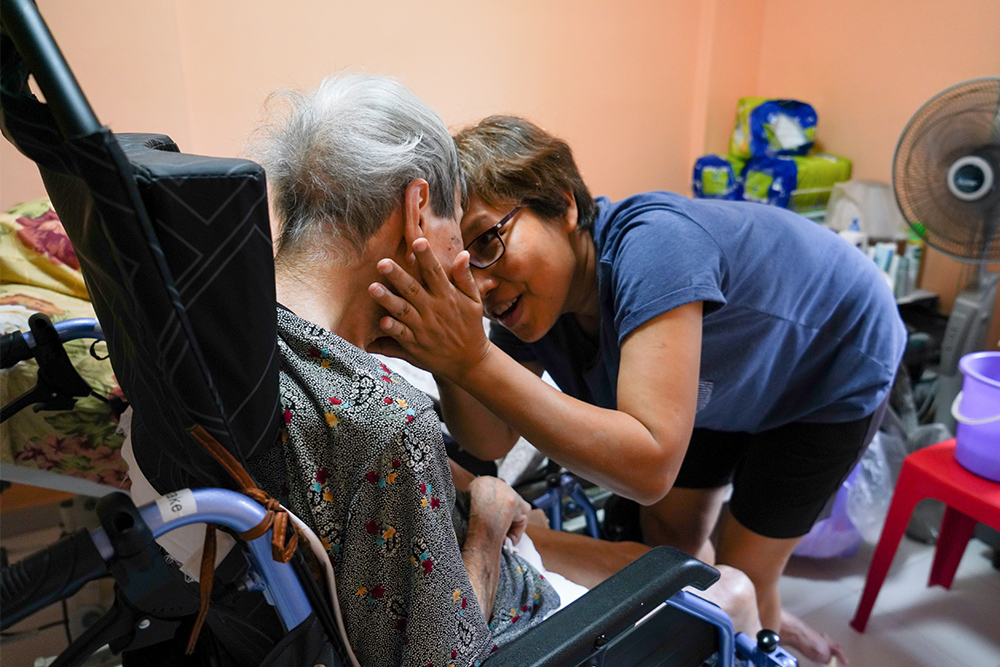Nurturing Resilience: How Strength-Based Practices Benefit the Elderly
In the face of these challenges, how can we, as social
service providers, caregivers, and community members, offer meaningful support?
The answer lies in a transformative approach known as strength-based practice.
Rather than focusing on what the elderly can no longer do, this approach
emphasizes their abilities, resilience, and potential. It’s about shifting the
narrative from one of decline to one of empowerment, recognizing that within
every senior lies a wealth of experience, wisdom, and strength waiting to be
harnessed.
This blog delves into the power of strength-based practices
in social services, exploring how this approach can foster resilience, enhance
well-being, and ultimately improve the quality of life for the elderly. We will
look at the unique challenges faced by seniors and how focusing on their
strengths—not their limitations—can lead to profound positive changes. Through
real-life examples and practical applications, we’ll see how this approach is
not just beneficial but essential in helping our aging population thrive.
Understanding Strength-Based Practices
Strength-based practices, also known as asset-based or capacity-focused approaches, are rooted in the belief that every individual has inherent strengths and resources that can be harnessed to overcome challenges and improve well-being. This approach contrasts with traditional deficit-based models that focus primarily on diagnosing problems, weaknesses, and limitations. By emphasizing what individuals and communities can do, rather than what they cannot, strength-based practices aim to empower people, fostering a sense of agency and resilience.
Theoretical Foundations
The strength-based approach is grounded in several
theoretical frameworks, including positive psychology, social work, and
community development. Positive psychology, introduced by Martin Seligman and
Mihaly Csikszentmihalyi, emphasizes the study of strengths, virtues, and
factors that contribute to human flourishing. According to Seligman (2002),
focusing on positive traits such as optimism, resilience, and personal
strengths leads to better mental health and life satisfaction. This perspective
is integral to strength-based practices, which prioritize identifying and
cultivating these attributes.
Social work, particularly within the frameworks of empowerment theory and ecological systems theory, also provides a foundation for strength-based practices. Empowerment theory, as discussed by Zimmerman (2000), emphasizes enhancing individuals' control over their lives and environments. Ecological systems theory, proposed by Bronfenbrenner (1979), highlights the complex interplay between individuals and their surrounding systems—families, communities, and societal structures. Strength-based practices align with these theories by recognizing the potential within individuals and their environments to create positive change.
Principles of Strength-Based Practices
Several key principles underpin strength-based practices:
- Focus
on Strengths, Not Deficits: Rather than concentrating on problems or
deficits, strength-based practices identify and build upon the existing
strengths of individuals and communities. Saleebey (1996) argues that this
approach enhances self-efficacy and motivation, as people are more likely
to engage in positive behaviors when they recognize their own capacities.
- Collaboration
and Partnership: Strength-based practices involve collaborative
relationships between service providers and individuals. This partnership
is based on mutual respect and shared decision-making, ensuring that
individuals are active participants in their own care. This principle is
rooted in the belief that people are experts in their own lives and have
valuable insights to contribute.
- Holistic
Perspective: A holistic approach considers the whole person, including
their physical, emotional, social, and spiritual dimensions. It
acknowledges the interconnectedness of various aspects of life and seeks
to address challenges in a comprehensive manner.
- Empowerment
and Self-Determination: Empowerment is central to strength-based
practices. By focusing on strengths, individuals are encouraged to take
control of their own lives, make informed decisions, and set goals that
are meaningful to them.
- Resilience Building: Resilience is the ability to adapt and thrive despite adversity. Strength-based practices aim to bolster individuals' resilience by enhancing their coping mechanisms, social supports, and problem-solving skills.
Applications in Social Services and Community Care
In the context of social services and community care,
strength-based practices have been applied in various settings, including
mental health, community development, and elder care. Research by McCashen
(2005) demonstrates that strength-based approaches in social work lead to
improved outcomes, such as increased client engagement, reduced dependency on
services, and enhanced well-being.
Seniors often face challenges such as declining health, loss
of independence, and social isolation. A strength-based approach can help
seniors rediscover their capabilities, engage in meaningful activities, and
maintain a sense of purpose. For example, studies have shown that
strength-based interventions can improve mental health outcomes for older
adults, including reductions in depression and anxiety (Healy, 2005).
How SBP Addresses Challenges Faced by Elderly
Here’s how strength-based practices effectively address the common challenges faced by seniors.
1. Physical Health Decline
Strength-based practices encourage older adults to recognize
and build on their existing physical capabilities, rather than focusing solely
on their limitations. For example, even if an elderly person has reduced
mobility, they may still possess considerable upper body strength, which can be
nurtured through tailored exercise programs. By celebrating small victories and
progress, such as improved stamina or flexibility, these practices help older
adults regain confidence in their physical abilities. Programs that emphasize
physical activity and rehabilitation, such as tai chi or chair yoga, align with
the strengths of the elderly, promoting better physical health and reducing the
risk of further decline (Kropf & Tandy, 1998).
2. Cognitive Decline
While cognitive decline is a significant challenge, strength-based practices focus on maintaining and enhancing cognitive function by leveraging an individual’s cognitive strengths. For example, an elderly person may have a sharp memory for long-term events or a keen ability to solve puzzles. Engaging in activities that stimulate the mind, such as memory games, storytelling, or learning new skills, can help maintain cognitive function. Moreover, creating environments that reduce stress and promote mental engagement can mitigate the impact of cognitive decline. This approach fosters a sense of competence and control, crucial for mental well-being (Cavanaugh & Blanchard-Fields, 2006).
3. Mental Health Issues
Strength-based practices are particularly effective in
addressing mental health challenges by shifting the focus from what is wrong to
what is right with the individual. For example, an elderly person experiencing
depression may still have strong social skills or a deep sense of spirituality.
By encouraging the use of these strengths, such as reconnecting with a faith
community or engaging in social activities, the elderly can find new meaning
and purpose. Additionally, recognizing and celebrating the resilience they have
shown throughout their lives can help combat feelings of hopelessness and
despair (Saleebey, 2012).
4. Social Isolation and Loneliness
To counteract social isolation and loneliness, strength-based practices emphasize the importance of social connections and community engagement.
Practitioners might help older adults identify and reconnect with supportive relationships or encourage participation in community groups that align with their interests and strengths, such as gardening clubs, volunteer opportunities, or faith-based activities. By focusing on what they can contribute rather than what they lack, the elderly are empowered to rebuild and maintain meaningful social networks, reducing feelings of loneliness (Healy, 2014).
5. Financial Insecurity
Strength-based approaches also address financial insecurity by helping the elderly identify and utilize their financial management skills, as well as access community resources.
For instance, an elderly person might be
guided to volunteer or mentor in areas where they have expertise, which can
provide a sense of purpose and sometimes even modest financial benefits.
Additionally, practitioners can assist in connecting them with resources like
financial planning services, senior discounts, or government assistance
programs, emphasizing their ability to navigate these systems effectively
(Canda & Furman, 2010).
6. Loss of Independence
Addressing the loss of independence, strength-based practices focus on empowering older adults to maintain as much autonomy as possible. This might involve adapting their living environment to suit their current abilities, teaching new skills, or finding innovative ways for them to continue performing daily tasks.
By reinforcing their ability to make decisions and manage their own lives, even in small ways, these practices help older adults retain a sense of control and self-determination (Gitterman & Germain, 2008).
7. Bereavement and Grief
Strength-based practices support older adults in coping with
bereavement and grief by helping them tap into their resilience and past
experiences of loss. Practitioners might encourage storytelling as a way for
the elderly to share their memories and celebrate the lives of those they have
lost. They may also help them find new roles or purposes that honor their loved
ones, such as volunteering or participating in legacy projects. By focusing on
what the elderly person can still offer to the world, rather than what they
have lost, these practices provide a path to healing and renewed purpose
(Sheafor & Horejsi, 2012).
8. Ageism and Societal Attitudes
To combat ageism, strength-based practices empower the
elderly to challenge negative stereotypes by showcasing their capabilities and
contributions. This might involve encouraging older adults to take on visible
roles in their communities, share their life experiences with younger
generations, or participate in advocacy efforts. By highlighting their
strengths and achievements, these practices help older adults reclaim their
dignity and assert their value in society, countering the harmful effects of ageism
(Saleebey, 2012).
9. Caregiver Burden
Strength-based practices also extend to supporting caregivers by helping them recognize their strengths and resilience. For some younger seniors who are caregivers, these practices encourage them to focus on the positive aspects of caregiving, such as the deep bonds and sense of purpose it can foster.
Additionally, strength-based approaches can help caregivers identify and access support systems, whether through family, community resources, or respite care, reducing stress and enhancing their capacity to care for their loved ones (Greene, 2017).
Strength-Based Approach in Practice
1. Assessment of Strengths
- Objective:
The first step in implementing a strength-based approach is to conduct a
comprehensive assessment of the individual’s strengths, resources, and
capabilities. This involves identifying both personal and environmental
strengths.
- Process:
- Strengths
Inventory: Utilize tools such as a strengths-based interview or
questionnaire that focuses on the individual's past achievements, skills,
interests, social networks, coping strategies, and life experiences.
- Collaborative
Exploration: Engage the individual in a dialogue that allows them to
articulate what they believe to be their strengths, what has worked for
them in the past, and what they enjoy doing.
- Resource
Mapping: Identify external resources such as community organizations,
social networks, and family support that can be leveraged to enhance the
individual’s strengths.
- Objective:
The next step is to collaboratively set goals that are aligned with the
identified strengths. This ensures that the individual is working towards
achievable and meaningful objectives.
- Process:
- Person-Centered
Goals: Establish goals that are specific, measurable, attainable,
relevant, and time-bound (SMART), ensuring they are grounded in the
individual’s strengths and personal aspirations.
- Empowerment
through Choice: Ensure the individual is actively involved in the
goal-setting process, allowing them to choose the areas they want to
focus on.
- Focus
on Positive Outcomes: Emphasize goals that not only address
challenges but also enhance the individual’s quality of life by
leveraging their strengths.
- Objective:
Create a detailed action plan that outlines the steps needed to achieve
the set goals, using the identified strengths as the foundation.
- Process:
- Strength-Based
Strategies: Develop strategies that utilize the individual’s
strengths in creative ways to overcome barriers and achieve goals. For
example, if an elderly person has a strong social network, their plan
might include increased engagement with friends and community groups.
- Resource
Allocation: Ensure that the necessary resources, such as access to
community programs or health services, are aligned with the action plan.
- Flexibility
and Adaptation: Allow for flexibility in the action plan to adapt to
changes in circumstances or needs, always maintaining a strengths focus.
- Objective:
Implement the action plan while providing ongoing support and
encouragement to ensure the individual remains engaged and motivated.
- Process:
- Regular
Check-Ins: Schedule regular follow-up meetings to review progress,
address challenges, and adjust the plan as needed.
- Support
Networks: Encourage the involvement of family, friends, and community
members in providing support, reinforcing the individual’s strengths.
- Positive
Reinforcement: Continuously acknowledge and celebrate successes, no
matter how small, to maintain motivation and reinforce the use of
strengths.
5. Evaluation and Reflection
- Objective:
Evaluate the outcomes of the strength-based approach and reflect on the
process to identify areas for improvement and to reinforce successful
strategies.
- Process:
- Outcome
Measurement: Use both qualitative and quantitative measures to assess
the effectiveness of the intervention, such as improvements in physical
health, mental well-being, and quality of life.
- Feedback
Loop: Engage the individual in reflecting on what worked well and
what could be improved, ensuring their perspective is central to the
evaluation.
- Sustained
Change: Discuss strategies for maintaining the positive changes
achieved and how the individual can continue to leverage their strengths
in the future.
Benefits of Strength-Based Practices
1. Enhanced Self-Efficacy
- Empowerment:
Strength-based practices empower individuals by focusing on their
abilities, past successes, and resources. This empowerment can enhance
self-efficacy, making individuals more confident in their capacity to
manage challenges and achieve their goals.
- Increased
Motivation: When individuals recognize their strengths, they are more
likely to feel motivated and engaged in their personal development and
problem-solving efforts.
2. Improved Mental Health
- Reduced
Depression and Anxiety: By emphasizing strengths and positive
attributes, individuals can experience reduced symptoms of depression and
anxiety. This shift in focus helps in building resilience and coping
mechanisms.
- Positive
Self-Image: A strengths-based approach can improve self-esteem and
foster a more positive self-image by highlighting and validating an
individual’s abilities and achievements.
3. Greater Resilience
- Coping
with Adversity: Strength-based practices equip individuals with the
tools and mindset needed to navigate and overcome adversity. By building
on existing strengths, individuals can better manage stress and adapt to
changes.
- Enhanced
Problem-Solving: Focusing on strengths encourages creative
problem-solving and resourcefulness, helping individuals address
challenges more effectively.
4. Strengthened Relationships
- Improved
Communication: Emphasizing strengths can lead to more constructive and
supportive communication within families and communities. Individuals
learn to appreciate and build on each other’s strengths rather than
focusing on deficits.
- Increased
Support Networks: Recognizing and utilizing personal and social
strengths can help individuals build stronger support networks and foster
positive relationships.
5. Greater Autonomy and Independence
- Enhanced
Functioning: Strength-based practices promote autonomy by encouraging
individuals to take charge of their own lives and decisions. This leads to
greater independence and self-sufficiency.
- Increased
Life Satisfaction: As individuals gain confidence and independence
through strength-based practices, they often experience greater
satisfaction with their lives and a stronger sense of purpose.
6. Holistic Development
- Comprehensive
Growth: By focusing on strengths, individuals can achieve growth
across various areas of their lives, including emotional, social, and
cognitive domains. This holistic development supports overall well-being
and quality of life.
- Balanced
Approach: Strength-based practices promote a balanced approach to
personal development, considering both individual strengths and external
resources.
7. Enhanced Service Delivery
- Client-Centered
Approach: For social service providers, adopting a strength-based
approach leads to more client-centered service delivery. Practitioners
work collaboratively with clients to leverage their strengths, resulting
in more effective and personalized interventions.
- Increased
Engagement: Clients are more likely to be engaged and committed to the
intervention process when they feel their strengths are acknowledged and
utilized.
8. Sustainable Change
- Long-Term
Impact: Strength-based practices support sustainable change by
fostering self-reliance and resilience. Individuals are equipped to
continue using their strengths to navigate future challenges
independently.
- Empowerment
for Future: By focusing on strengths, individuals develop skills and
attitudes that can be applied in various aspects of their lives, promoting
long-term well-being and success.
Case Study: Improving Well-Being through SBP
Background:
Mrs. Evelyn Wong, a 72-year-old retiree, faced significant challenges following the loss of her husband two years ago. She had been diagnosed with early-stage arthritis and was struggling with feelings of isolation and depression. Evelyn had always been an active member of her community, known for her involvement in local volunteer work and her dedication to maintaining an active lifestyle, including gardening and leading a book club.
Initial Assessment:
Upon receiving support from a local senior services
organization, Evelyn was initially assessed by a social worker who identified
her primary issues as mild depression, loneliness, and a decline in physical
health. She had become increasingly withdrawn and was reluctant to participate
in activities she once enjoyed.
Strength-Based Intervention:
- Identifying
Strengths and Resilience:
- The
social worker conducted a series of interviews with Evelyn to explore her
past achievements and resilience. Through these discussions, Evelyn
reflected on her history of volunteer work, her role as a community
leader, and her resilience in overcoming personal challenges, such as
raising her children as a single mother while maintaining her career.
- Reconnecting
with Past Interests:
- Based
on Evelyn's past achievements and interests, the social worker encouraged
her to reconnect with her passions. Evelyn was supported in restarting
her gardening hobby and taking on a leadership role in a local gardening
club. This helped her re-engage with her community and build a sense of
purpose.
- Building
on Existing Social Networks:
- The
social worker facilitated connections with former friends and colleagues,
creating opportunities for Evelyn to reconnect with her social network.
She was invited to participate in social events and support groups
tailored to her interests.
- Setting
Achievable Goals:
- Evelyn
was guided to set small, achievable goals based on her strengths. These
included organizing a community gardening event and leading a book club
discussion on a topic she was passionate about.
Outcomes:
- Improved
Mental Health:
- As
Evelyn re-engaged with her hobbies and community, her depressive symptoms
significantly decreased. She reported feeling more optimistic and
motivated, and her interactions with others became more positive and
frequent.
- Increased
Physical Activity:
- Reconnecting
with gardening led to increased physical activity, which had a positive
impact on her arthritis symptoms and overall physical health. Evelyn
noted improvements in her mobility and energy levels.
- Strengthened
Social Connections:
- By
rebuilding her social network and participating in community activities,
Evelyn experienced reduced feelings of loneliness. Her increased social
interactions provided emotional support and a sense of belonging.
- Enhanced
Self-Efficacy:
- Focusing on her past achievements and strengths helped Evelyn regain confidence in her ability to contribute to her community and manage her health. She felt empowered and capable of handling future challenges.
By applying a strength-based approach, Evelyn Wong's quality
of life significantly improved. Emphasizing her past achievements and personal
resilience led to better mental health outcomes, increased physical activity,
and stronger social connections. This case illustrates the positive impact of
focusing on an individual's strengths and past successes to foster well-being
and resilience in seniors.
Conclusion
Incorporating strength-based practices in social services
for the elderly represents a transformative approach to improving well-being
and quality of life. By focusing on individuals' inherent strengths, past
achievements, and resilience, this approach empowers seniors to overcome
challenges and enhance their overall mental and physical health.
The strength-based approach contrasts sharply with
deficit-based models that concentrate on limitations and problems. Instead, it
builds on the positive attributes and experiences of individuals, fostering a
sense of self-efficacy and purpose. For elderly individuals like Mrs. Evelyn
Wong, focusing on their past successes and reconnecting with their passions can
lead to profound improvements in mental health, physical well-being, and social
connectivity.
This approach not only benefits the elderly by enhancing their quality of life but also supports caregivers and family members by reducing stress and promoting a more balanced caregiving dynamic. By emphasizing resilience and personal strengths, social services can provide more holistic and empowering support to seniors, paving the way for a more fulfilling and engaged life.
Overall, the strength-based practice is a valuable tool in addressing the complex needs of the elderly, promoting positive behavioral changes, and fostering resilience. As social services continue to evolve, integrating these principles into practice will be crucial in creating supportive environments that honor and build upon the strengths of every individual.
Healy, K. (2014). Social Work Theories in Context: Creating
Frameworks for Practice. This book discusses various social work theories,
including the strengths perspective, and how they can be applied in practice.
Saleebey, D. (2012). The Strengths Perspective in Social
Work Practice. This book highlights the benefits of focusing on strengths,
including increased self-efficacy and improved mental health.
Rapp, C. A., & Goscha, R. J. (2011). The Strengths
Model: Case Management with People with Psychiatric Disabilities. This text
discusses how strength-based practices enhance resilience and problem-solving
abilities.
McCashen, W. (2005). The Strengths Approach: A
Strengths-Based Practice for Social Workers. McCashen’s work emphasizes how
strength-based practices contribute to holistic development and improved
service delivery.
























Comments
Post a Comment